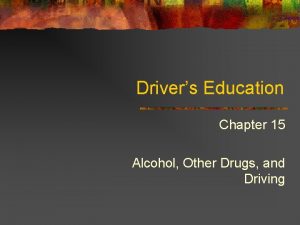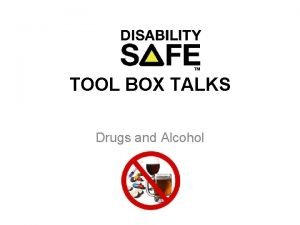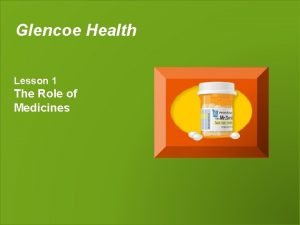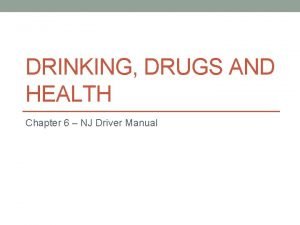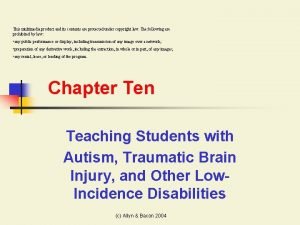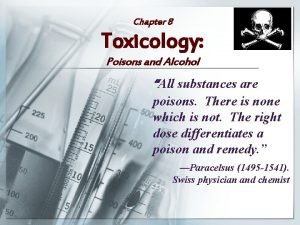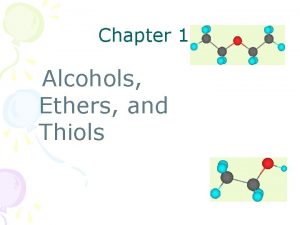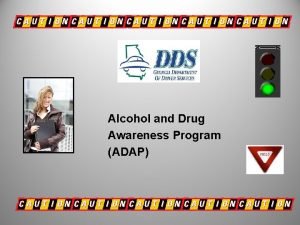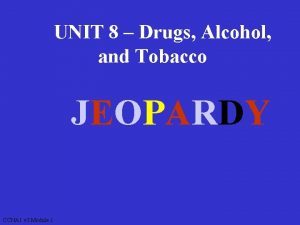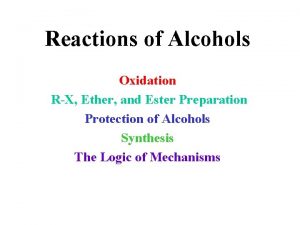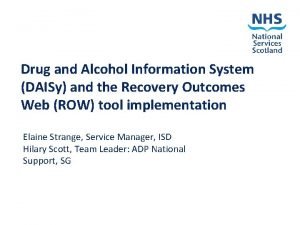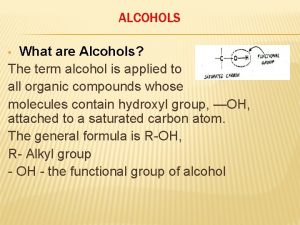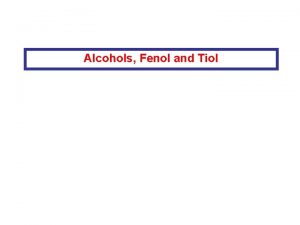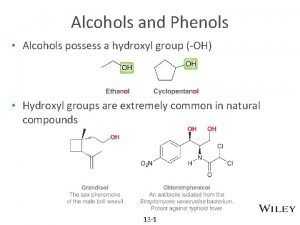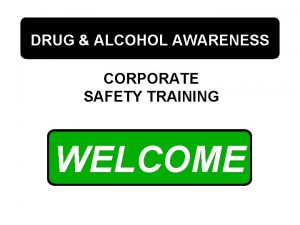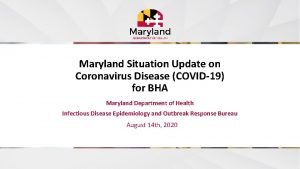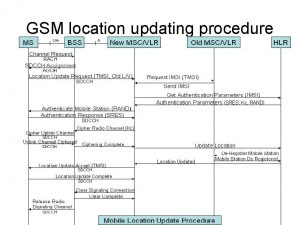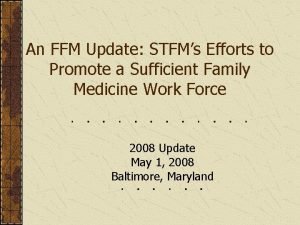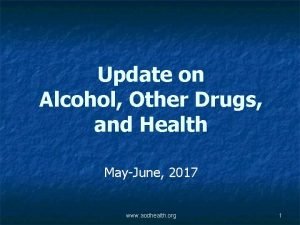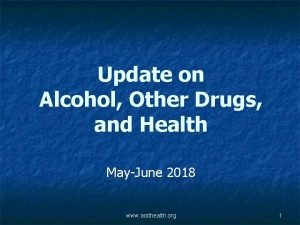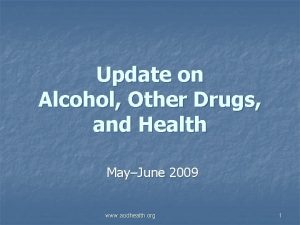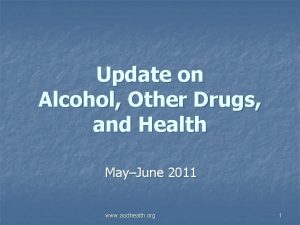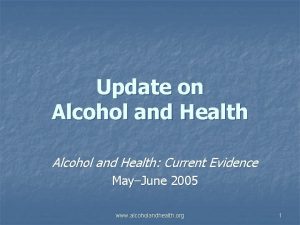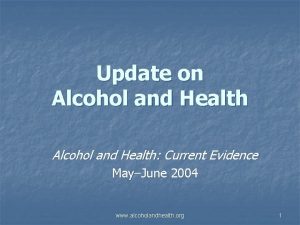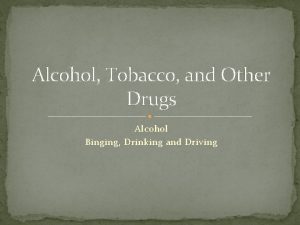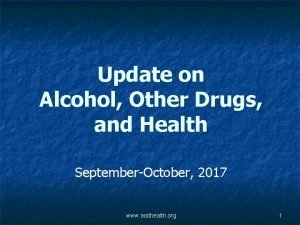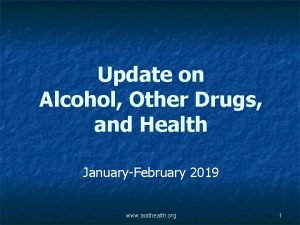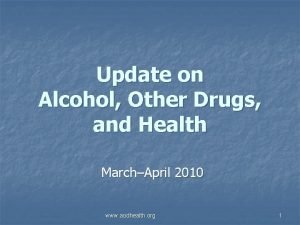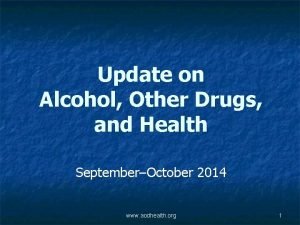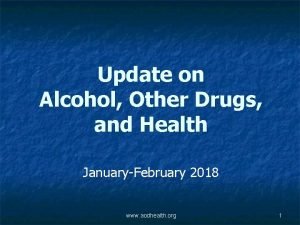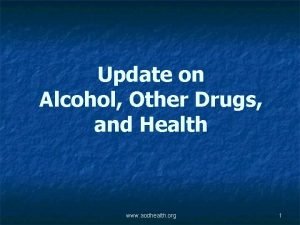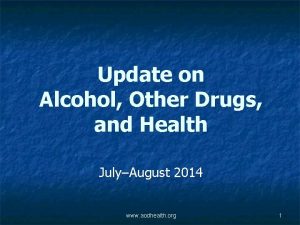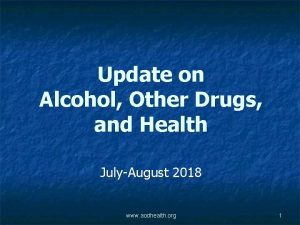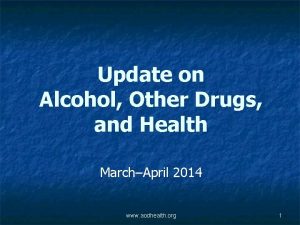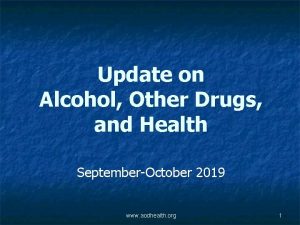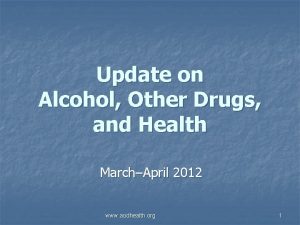Update on Alcohol Other Drugs and Health MayJune







































































- Slides: 71

Update on Alcohol, Other Drugs, and Health May–June 2016 www. aodhealth. org 1

Studies on Interventions & Assessments www. aodhealth. org 2

Guideline-Concordant Long. Term Opioid Therapy Associated with Lower All. Cause Mortality Gaither JR, et al. J Gen Intern Med. 2016; 31(5): 492– 501. Summary by Darius A. Rastegar, MD www. aodhealth. org 3

Objectives/Methods n n n Long-term opioid therapy (Lt. OT, defined as receipt of opioid medication for ≥ 90 days) carries a risk of addiction and overdose. Guidelines have been developed to guide practitioners, but there is scant evidence to support them. Researchers used data from the Veterans Aging Cohort Study (patients with HIV infection and matched [1: 2] with controls) to investigate the association between guidelineconcordant care and all-cause mortality. www. aodhealth. org 4

Results n n Of approximately 120, 000 patients in the cohort, 26, 931 were identified as receiving Lt. OT; patients receiving palliative care or opioid agonists for opioid use disorder were excluded; 17, 044 were included in this analysis. During 1 year of follow-up there were 1048 deaths (6%). www. aodhealth. org 5

Results, cntd. n The table below shows propensity-matched hazard ratios (HR) and 95% confidence intervals (CI) for all-cause mortality associated with 6 specific guidelines; researchers looked for the receipt of any of these within 180 days of Lt. OT start date. Guideline Primary care follow-up within 2– 4 weeks of Lt. OT start and every 1– 6 months thereafter Urine drug testing as part of assessment and periodically thereafter Co-prescription of sedatives (guidelines recommend to avoid) Substance use disorder (SUD) treatment for those with SUD Physical rehabilitation therapy (physical/occupational therapy or rehabilitation clinic) Psychotherapeutic co-interventions (≥ 2 mental health visits) www. aodhealth. org Propensitymatched HR (CI) 1. 12 (0. 90– 1. 40) 0. 96 (0. 78– 1. 17) 1. 39 (1. 12– 1. 66) 0. 47 (0. 32– 0. 68) 0. 81 (0. 67– 0. 98) 0. 62 (0. 51– 0. 75) 6

Comments n n This study supports a number of the guidelines, particularly regarding avoiding the co-prescription of sedatives. It also supports the use of physical rehabilitation and psychotherapeutic co-interventions at least among those who choose to engage in them. The fact that urine drug testing was not associated with lower mortality may have more to do with how clinicians used the results. Finally, there are number of guideline recommendations that were not assessed in this study, such as limiting the dosage of opioids, as well as the use of treatment agreements and prescription drug monitoring programs. www. aodhealth. org 7

Extended-Release Naltrexone Decreases Return to Opioid Use Among Individuals Involved with the Criminal Justice System Lee JD, et al. N Engl J Med. 2016; 374(13): 1232– 1242. Summary by Jeanette M. Tetrault, MD www. aodhealth. org 8

Objectives/Methods n n n Release from incarceration poses a vulnerable time for return to opioid use, overdose, and death among people with opioid use disorder (OUD). Barriers to widespread implementation of opioid agonist treatment (OAT) in this population include lack of availability and patient preference. Researchers examined the effectiveness of 24 weeks of extended-release naltrexone compared with usual care (brief counseling and referral to community treatment) among 308 community-dwelling criminal justice offenders who were at high risk for return to opioid use. www. aodhealth. org 9

Objectives/Methods, cntd. n n Participants had OUD, were opioid-free at the time of randomization, and preferred non-OAT approaches to treatment. All participants were encouraged to access community treatment and resources to prevent return to opioid use, including buprenorphine or methadone treatment if preferred or indicated during the trial and after the 24 -week treatment phase. www. aodhealth. org 10

Results n n During the 24 -week treatment phase, participants assigned to extended-release naltrexone had a longer median time to return to ≥ 10 days of opioid use (10. 5 versus 5 weeks), a lower rate of return to such use (43% versus 64%), and a higher rate of opioid-negative urine samples (74% versus 56%), compared with usual care. Compared with the extended-release naltrexone group, more participants in the usual care group pursued OAT during the trial (11% versus 37%), primarily after returning to opioid use. www. aodhealth. org 11

Results, cntd. n n At week 78, the proportions of opioid-negative urine samples were equal (46% in each group). There were more medication-related adverse events in the treatment group including injection site reaction, GI upset, and headache. Opioid overdose (fatal and nonfatal) was examined as an adverse event over 78 weeks of observation. There were no overdose events reported in the extended-release naltrexone group and 7 (3 fatal) in the usual care group. www. aodhealth. org 12

Comments n n This trial demonstrated the effectiveness of extendedrelease naltrexone in decreasing return to regular opioid use during the 24 -week treatment phase, which did not persist beyond the active treatment phase. Studies investigating the use of extended-release naltrexone immediately upon release from incarceration and studies directly comparing the use of extendedrelease naltrexone with OAT in this population are needed, but may not be feasible due to patient preference for treatment modality. www. aodhealth. org 13

Alcohol Consumption Monitoring with Sanctions for People Arrested for Alcohol. Related Crimes Associated with Reduced Mortality Nicosia N, et al. Lancet Psychiatry. 2016; 3(3): 226– 232. Summary by Alexander Y. Walley, MD, MSc www. aodhealth. org 14

Objectives/Methods n n In 2005, South Dakota implemented a program that combined frequent alcohol consumption monitoring with swift and certain sanctions for people who have committed alcohol-related crimes, like driving under the influence. Participants undergo twice-daily breathalyzer testing or wear a continuous alcohol monitor. A positive or skipped test results in an immediate jail term of 1– 2 days. Researchers conducted a study of the program to determine its impact on monthly county-level mortality 2005– 2011. Analyses controlled for county-level characteristics, including unemployment, snowfall, college attendance, and demographic rates. www. aodhealth. org 15

Results n n n Over 16, 000 people (3% of the population) participated in the program 2005– 2011. Implementation of the program was associated with a 4. 2% reduction in all-cause mortality. Women in particular seemed to benefit with an 8% reduction in all-cause mortality. www. aodhealth. org 16

Comments n n n A program that combines frequent alcohol monitoring with swift and certain sanctions may reduce mortality beyond the individuals enrolled directly in the program. Studies in other settings, those that include individual-level longitudinal outcomes, and those that incorporate randomization could confirm these findings and advance understanding of the mechanisms by which such a program may reduce mortality. The role of alcohol treatment in the context of a program of negative reinforcement for people at high risk for alcohol use disorder-related consequences warrants consideration and study. www. aodhealth. org 17

Methadone Treatment is Associated with Less Opioid Use And Better Retention Compared with Buprenorphine/Naloxone Hser YI, et al. Addiction. 2016; 111(4): 695– 705. Summary by Todd Kerensky, MD† and Alexander Y. Walley, MD, MSc † Contributing Editorial Intern and Addiction Medicine Fellow, Boston University/Boston Medical Center www. aodhealth. org 18

Objectives/Methods n n Methadone and buprenorphine are both better than placebo at reducing opioid use and retaining people with opioid use disorders in treatment. In previous studies, at higher doses the benefits from both medications were similar. However, studies of methadone and buprenorphine have been limited to less than 1 year. www. aodhealth. org 19

Objectives/Methods, cntd. n n Researchers conducted a single follow-up interview of participants who were enrolled in opioid treatment programs in an open-label, randomized 24 -week trial of buprenorphine/naloxone versus methadone to determine differences in mortality, treatment participation, and opioid use. Of the 1269 trial participants, 797 were interviewed to assess treatment participation and opioid use during the 5 -year follow-up period. www. aodhealth. org 20

Results n n There was no significant difference in mortality between participants randomized to methadone (5. 8%) compared with buprenorphine/naloxone (3. 6%). Treatment periods during which participants received either methadone or buprenorphine/naloxone were associated with decreased opioid use over the follow-up period, compared with those periods during which participants received no treatment. www. aodhealth. org 21

Results, cntd. n n Participants randomized to methadone spent more months in any treatment compared with the buprenorphine/naloxone group (63% versus 52% of followup months, respectively). Fewer participants randomized to methadone compared to those randomized to buprenorphine/naloxone were using opioids by self-report or urine toxicology (41% versus 51%) at the follow-up interview, even though participants could switch between buprenorphine/naloxone, methadone, or no treatment during the follow-up period. www. aodhealth. org 22

Comments n n n This study finds that methadone increased treatment participation and reduced opioid use more than buprenorphine/naloxone. Importantly, the data were obtained by following a large number of participants over an extended period of time, allowing participants to cycle between treatment(s) and no treatment, similar to real-world settings. However, care must be taken when interpreting the data, as participants were recruited from opioid treatment programs and a greater proportion of the buprenorphine/naloxone group dropped out of the study, requiring an adjustment in the randomization protocol. www. aodhealth. org 23

Studies on Health Outcomes www. aodhealth. org 24

“Moderate” Drinking May Not Reduce Mortality Risk Stockwell T, et al. J Stud Alcohol Drugs. 2016; 77(2): 185– 198. Summary by Richard Saitz, MD, MPH www. aodhealth. org 25

Objectives/Methods n n n Some believe that drinking small amounts of alcohol can decrease mortality. But the beneficial effects, if any, seem to peak at < 1 drink a day, and are based on studies with serious methodological challenges, not the least of which is the association between “moderate” drinking and numerous healthy characteristics not caused by alcohol (like past cancer screening or educational achievement). Even more important is the limitation that studies do not consider people who die (e. g. , from drinking-related injuries) or stop drinking before a middle- or older-aged cohort is recruited. www. aodhealth. org 26

Objectives/Methods, cntd. n n Scientists are beginning to question whether the observed associations between lower levels of alcohol consumption and decreased mortality are causal. To address these serious limitations in prior studies, investigators performed a systematic review and metaanalysis of 87 studies (including data on 3, 998, 626 people) that reported associations between alcohol consumption and all-cause mortality. www. aodhealth. org 27

Results n n The relative risk for all-cause mortality when compared with lifetime abstinence was: 0. 86 for low-volume drinking (average 1. 3 – < 25 g/day) in unadjusted analyses. 0. 89 for low-volume and 0. 86 for occasional drinking (average < 1. 3 g/day, not biologically plausibly associated) in analyses adjusted for selected covariates. 0. 97 (95% confidence interval, 0. 88– 1. 07) for low-volume drinking in analyses adjusted for age, sex, race, smoking, drinking measure adequacy, study biases, exclusion of ill participants, and follow-up. Note: 1 US standard drink = 12– 14 g alcohol. www. aodhealth. org 28

Comments n n This analysis does not address whether alcohol is associated with surrogate markers of disease (although an oft-cited review* of heart disease biomarkers found 9 of 13 studied were not). This analysis also did not review whether alcohol is associated with specific causes of death such as injury, cirrhosis, cancer, or heart disease. * Brien SE, Ronksley PE, Turner BJ, et al. Effect of alcohol consumption on biological markers associated with risk of coronary heart disease: systematic review and meta-analysis of interventional studies. BMJ. 2011; 342: d 636. www. aodhealth. org 29

Comments, cntd. n n Nonetheless, many people care about their risk of death regardless of cause and this study addressed major methodological limitations of prior reports. When adjusting for study flaws there appears to be no protective effect of low-volume drinking on mortality. Although the usual response to observational studies of “moderate” drinking is to call for randomized trials, these results suggest a lack of evidence for an effect and could raise ethical questions about doing so. www. aodhealth. org 30

E-Cigarette Use Not Associated with Tobacco Cigarette Smoking Cessation Intent Among French Youths Rennie LJ, et al. J Adolesc Health. 2016; 58(4): 440– 445. Summary by Sharon Levy, MD, MPH www. aodhealth. org 31

Objectives/Methods n n n Adolescent tobacco use continues to decline while the use of ecigarettes is on the rise. E-cigarettes contain liquid nicotine, which is delivered to the lungs as vapor. By some, they are thought to be safer than tobacco and promoted as a public health solution to smoking. However, nicotine is highly addictive and the long-term effects of exposure to the chemicals in e-cigarettes are unknown. Researchers examined correlates of e-cigarette experimentation among 1458 French adolescents (49% female, mean age 16 years). www. aodhealth. org 32

Results n n n Just over half of study participants had ever tried ecigarettes (54%), or tobacco cigarettes (55%). Of the sample, 20% of those who had tried e-cigarettes had never tried tobacco cigarettes. E-cigarette use was not associated with tobacco cigarette cessation intent. www. aodhealth. org 33

Comments n n In the US, e-cigarettes are widely available and some are sold in “vape shops” that market them as safe recreation, making them appealing to teens and young adults, the groups most likely to be harmed by these products. As the authors suggest, one approach to curbing the increasing use of e-cigarettes may be regulation of their marketing and implementing health messages to prevent uptake, particularly among people who do not smoke tobacco cigarettes. www. aodhealth. org 34

Which Youth with Alcohol and Drug-Related Injuries Are At Highest Risk For Future Death And Emergency Readmission? Herbert A, et al. PLOS Med. 2015; 12(12): e 1001931. Summary by Kevin L. Kraemer, MD, MSc www. aodhealth. org 35

Objectives/Methods n n Serious injury in adolescents may offer an opportunity to intervene and prevent future injury and death. However, it is unknown which injured adolescents are at greatest risk for future adverse health outcomes. Researchers used UK National Health Service data to identify adolescents (age 10– 19 years), hospitalized for injury between 1997 and 2012: 333, 009 for “adversity-related” (violent, drug or alcohol-related, or self-inflicted) injury and 649, 818 hospitalized for “accident-related” injury. They then compared rates of death and emergency readmission by gender, age, and injury group within 10 years of the index hospitalization. www. aodhealth. org 36

Results n n Drugs and/or alcohol caused the majority of adversity-related injuries (90% in girls; 57% in boys). Compared with accident-related injury, adversity-related injury was associated with an increased risk of death in girls (hazard ratio [HR], 1. 61) and boys (HR, 2. 13) within 10 years. Compared with accident-related injury, adversity-related injury was associated with increased risk of emergency readmission in girls (HR, 1. 76) and boys (HR, 1. 41) within 10 years. In both boys and girls, risk for death and emergency readmission increased with older age at the index injury hospitalization and was highest after drug/alcohol-related or self-inflicted injury. www. aodhealth. org 37

Comments n n n This large study indicates an increased 10 -year risk for death and emergency readmission among older youth and those admitted for injury from violence, alcohol, drugs, or self-infliction. Although there may have been some residual confounding in this secondary analysis, the results certainly have face validity. The challenge will be the development and implementation of effective interventions to prevent future harm. www. aodhealth. org 38

In Patients with Psychosis, Cannabis Use Is Associated with Adverse Clinical Outcomes Schoeler T, et al. Lancet Psychiatry. 2016; 3(3): 215– 225. Summary by Nicolas Bertholet, MD, MSc www. aodhealth. org 39

Objectives/Methods n n n The link between cannabis use and the development of psychosis is established. This systematic review and meta-analysis of 24 studies summarizes the evidence of the impact of cannabis use after the onset of psychosis (schizophrenia, schizoaffective, or bipolar if outcome was reported as number of psychotic episodes). Researchers compared the outcomes of those who continued using cannabis, those who stopped, and those who did not have cannabis use. www. aodhealth. org 40

Results n n Irrespective of the stage of the psychotic disorder, continued cannabis use was associated with a greater risk of recurrence of psychosis, compared with people without cannabis use (Cohen’s d=0. 36) and those who discontinued use (d=0. 28). Those who continued cannabis use had longer hospital admissions compared with those without cannabis use (d=0. 36). People with cannabis use spent an additional 8. 5 days per year in the hospital (for psychosis symptoms). Note: Cohen’s d of ≤ 0. 2 indicates small effects, 0. 4 to 0. 6 moderate effects, and ≥ 0. 8 large effects. www. aodhealth. org 41

Results, cntd. n n Relapse to psychosis did not differ between those who discontinued cannabis and those without cannabis use (d=0. 02). Continued cannabis use predicted severity of positive psychotic symptoms (e. g. , hallucinations, delusions, disorganization), but not negative symptoms (e. g. , absent or blunted emotional response, monotone speech, difficulty initiating tasks or thinking, anhedonia, apathy, social withdrawal). Those who discontinued cannabis use showed a better level of functioning. www. aodhealth. org 42

Comments n n n This study suggests that cannabis has an impact on psychosis, and that the increased risk of symptoms might disappear after abstinence. These results are limited by the heterogeneity in the selected studies, including heterogeneity in the types of cannabis—information rarely available in the original studies—even though the cannabis ingredients (THC, cannabidiol) may have different effects on brain function. Nevertheless, it calls for cannabis use as an important target for intervention among patients with psychosis. www. aodhealth. org 43

New Meta-Analysis Investigates Alcohol Consumption and the Risk of Pancreatic Cancer Wang YT, et al. BMC Cancer. 2016; 16(1): 212. Summary by R. Curtis Ellison, MD www. aodhealth. org 44

Objectives/Methods n n Researchers performed a meta-analysis on data from over 4 million people in prospective cohort studies, among whom 11, 846 incident cases of pancreatic cancer were diagnosed. With people with no alcohol intake or the “lowest” intake as the referent group, the authors defined “light” consumption as an average of 0– 12 g alcohol in a day, ≥ 12– 24 g in a day as “moderate, ” and ≥ 24 g in a day as “heavy. ” www. aodhealth. org 45

Results n n n Compared with the referent group, patients with “heavy” drinking had a slight increase in risk of pancreatic cancer (relative risk [RR], 1. 15); those with “light” (RR, 0. 97) or “moderate” consumption (RR, 0. 98) did not show an increase. The increase in risk was attributed to “heavy” consumption of liquor, as there was no significant increase in risk for “heavy” consumption of beer (RR, 1. 08) or wine (RR, 1. 09). Results showed a significant increase in risk of pancreatic cancer associated with alcohol consumption among men but not women. www. aodhealth. org 46

Comments n n Among the weaknesses of the study are the combining of lifetime abstainers with those with prior alcohol use in the referent group (which could bias the results for “light” and “moderate” drinking in either direction), using the same cutpoints for category of alcohol intake for both men and women, and a lack of data on the patterns of drinking. The lack of a significant association with cancer risk for any level of consumption of beer or wine could relate to the lower concentration of alcohol per volume of the beverage, the effects of non-alcoholic substances (such as polyphenols, present in wine and beer), or even to different drinking practices among participants consuming different beverages, or even to statistical limitations because of variability in the data making detection of effects less likely. www. aodhealth. org 47

Studies on HIV and HCV www. aodhealth. org 48

Among People with HIV Who Inject Drugs, Incarceration Is A Barrier To Antiretroviral Therapy While Engagement In Methadone Treatment Promotes It Joseph B, et al. AIDS. 2016; 30: 925– 932. Summary by Darius A. Rastegar, MD www. aodhealth. org 49

Objectives/Methods n n n Current guidelines recommend initiation of antiretroviral therapy (ART) for all individuals with HIV, both to improve clinical outcomes and to reduce transmission. People who inject drugs (PWID) are at risk for HIV infection and are less likely to engage in ART. Researchers used data from 2 cohorts of PWID in Vancouver, Canada—where access to ART is available at no cost—to investigate the association between initiation of ART and other factors. www. aodhealth. org 50

Results n n n Of 133 participants who met inclusion criteria, 98 (74%) initiated ART during the study period. On multivariable analyses, engagement in methadone maintenance was positively associated with initiation of ART (adjusted hazard ratio [a. HR], 2. 41). Two factors were negatively associated with initiation of ART: engaging in informal income generation (sex work, drug dealing, theft, or other activities; a. HR, 0. 51) and incarceration (a. HR, 0. 52). Factors that were not significantly associated with initiation of ART included age, gender, race, education, and homelessness. www. aodhealth. org 51

Comments n n n The findings of this study are consistent with prior observations that engagement in opioid agonist treatment facilitates the treatment of HIV. With regard to incarceration, the findings are not consistent with some studies that have shown that this can facilitate the initiation and optimization of ART. In any case, HIV care should include agonist treatment for those who need it and involvement with the criminal justice system should be used as an opportunity to address both addiction and HIV infection. www. aodhealth. org 52

Pregnant Women with Opioid Use Disorder and Hepatitis C Infrequently Receive Hepatitis C Services Krans EE, et al. Subst Abuse. 2016; 37: 88– 95. Summary by Kevin L. Kraemer, MD, MSc www. aodhealth. org 53

Objectives/Methods n n n Pregnant women with opioid use disorder (OUD) have a high prevalence of hepatitis C (HCV) infection and, if infected, may transmit the virus to their children at delivery. Researchers retrospectively assessed data on 791 pregnant women (97% white, 13% married, 17% employed) receiving opioid agonist therapy (OAT) who received prenatal services at a single large academic medical center. They assessed whether the women were screened for HCV (either an HCV antibody test or documentation of a prior positive test), for predictors of screening, and, if infected, whether the women received HCV viral load testing, hepatitis A vaccine, hepatology referral (and attendance), and postpartum HCV treatment. www. aodhealth. org 54

Results n n n 611 (72%) pregnant women receiving OAT were screened for HCV and, of those screened, 369 (60%) were infected. In adjusted analyses, HCV screening was more likely to occur in women with benzodiazepine use (odds ratio [OR], 1. 7), injection drug use (OR 6. 2), legal problems (OR 2. 2), children not in mother’s custody (OR 1. 8), and partner with substance use (OR 2. 4). Screening was less likely in married women (OR 0. 5), private prenatal practice (OR 0. 3), and among women receiving buprenorphine (OR 0. 5). Among women with HCV, the rates of receiving specific HCV services were: HCV viral load testing (26%), hepatitis A vaccination (10%), referral to hepatology during pregnancy (77%), attendance at hepatology (25%), and postpartum HCV treatment (2%). www. aodhealth. org 55

Comments n n Although it was conducted at a single site, this study illustrates some important gaps in the care of pregnant women with OUD. Certainly, a case can be made that given its high prevalence, pregnant women with OUD should have HCV screening done to identify their treatment needs and whether or not to treat the neonate. n n The low rates of services among the HCV-infected pregnant women with OUD indicate a need for improved quality and coordination of HCV care during and after pregnancy. The availability of effective interferon-free antiviral therapy makes the improvement of prenatal and postpartum HCV services even more pressing. www. aodhealth. org 56

Patterns of HCV Transmission May Inform Treatment-As. Prevention Efforts Among People Who Inject Drugs Jacka B, et al. J Hepatol. 2016; 64(6): 1247– 1255. Summary by Seonaid Nolan, MD www. aodhealth. org 57

Objectives/Methods n n n Hepatitis C (HCV) treatment has been shown to substantially reduce HCV prevalence and transmission among people who inject drugs (PWID). Existing literature, however, has focused on HCV acquisition. To gain a better understanding of HCV transmission among this population, researchers investigated phylogenetic patterns of HCV transmission among 699 young (< 27 years) and older (≥ 27 years old) PWID with HCV in Vancouver, Canada and assessed factors associated with pairing (2 participants with phylogenetically-related virus) and clustering (> 3 participants with phylogenetically-related virus) of infections. www. aodhealth. org 58

Results n n Of the participants, 26% were female, 22% were < 27 years old, 10% seroconverted at some point during the 16 year follow-up period, * 50% were infected with HCV genotype 1 a, and 24% had concurrent HIV infection. When viral lineage was restricted to clusters believed to have emerged in the previous 5 years, 15% of participants’ HCV infections were phylogenetically related (86 pairs, 21 clusters). *HCV antibody negative at study enrollment followed by HCV antibody positive at subsequent study visit (1996 -2012). www. aodhealth. org 59

Results, cntd. n n HCV transmission occurred both within and between younger and older PWID. Factors associated with phylogenetic clustering included: younger age, shorter duration since injecting initiation, HIV co-infection, and HCV genotype 3 a infection. www. aodhealth. org 60

Comments n n In this population of PWID, many HCV infections among participants < 27 years occurred due to transmission events between older and younger PWID, highlighting the fact that treatment-as-prevention strategies will require broad scale-up among both age cohorts. While injecting patterns and networks likely vary based on local factors, these results emphasize how phylogenetic studies can be used to better understand potentially intervene on the dynamic nature of HCV epidemics among PWID in other settings. www. aodhealth. org 61

Increasing Patients’ Knowledge About HCV May Promote Engagement in HCV Care Zeremski M, et al. J Addict Med. 2016; (2): 102– 107. Summary by Jenna L. Butner, MD† and Jeanette M. Tetrault, MD † Contributing Editorial Intern and Clinical Instructor, General Internal Medicine, Yale University. www. aodhealth. org 62

Objectives/Methods n n Patients with unhealthy substance use may lack knowledge about hepatitis C (HCV) infection and treatment, leading to barriers to care. Researchers administered a comprehensive educational intervention designed to address knowledge gaps regarding HCV to 111 patients receiving treatment with methadone. The intervention was composed of two 30– 60 -minute sessions. n n The first focused on HCV transmission, risk factors, and symptoms; the second on diagnostic testing, treatment, and prevention. A 15 -item pre- and post-test questionnaire included demographics, information on drug use in the past 6 months, HCV knowledge, and willingness to be treated for HCV. Seven of the 15 items focused on HCV knowledge. www. aodhealth. org 63

Results n The mean age of participants was 55 years; 59% were male, 70% African American, and 30% Hispanic. Overall, 59% reported a history of injection drug use, 94% were unemployed, and 57% were receiving disability. Sixty percent of participants were HCV-seropositive; of this group 73% had detectable HCV RNA. www. aodhealth. org 64

Results, cntd. n n n Patients’ HCV knowledge level (answering ≥ 5 of 7 test questions correctly) was 66% (pre-intervention) versus 84% (post-intervention). Male sex and having been screened for HCV before the intervention were associated with higher HCV-related knowledge post-intervention. 85% of patients with HCV were willing to receive treatment pre- and post-intervention. www. aodhealth. org 65

Comments n n n HCV-related educational interventions may enhance the willingness of infected patients receiving treatment with methadone to undergo HCV treatment. It is important to note that this study was conducted just as direct acting antivirals (DAA) were being introduced. Future studies should include patients with other substance use disorders—in order to assess knowledge of and attitudes towards HCV on a larger scale during the DAA-era. www. aodhealth. org 66

Studies on Prescription Drugs and Pain www. aodhealth. org 67

New CDC Guidelines Recommend Limits on Prescribing Opioids for Chronic Pain “CDC guideline for prescribing opioids for chronic pain — United States, 2016. ” Morbidity and Mortality Weekly Report. 2016; 65. Dowell D, et al. JAMA. 2016; 315(15): 1624– 1645. Summary by Joseph Merrill, MD, MPH www. aodhealth. org 68

Objectives/Methods n n Increases in opioid prescribing for chronic pain and the epidemic of opioid use disorder and overdose death underscore the need for safer prescribing practices. The US Centers for Disease Control and Prevention recently released opioid prescribing guidelines aimed at primary care clinicians treating adults with chronic non-malignant pain, citing a lack of evidence for long-term (> 1 year) benefits and evidence of possible harms from opioids, as well as benefits of non-pharmacologic and non-opioid pharmacologic therapy. www. aodhealth. org 69

Results Recommendations were provided in 3 areas: n. Opioid initiation and continuation: preference for nonpharmacologic treatments and non-opioid medications, establishment of goals, and discussion of risks and benefits. n. Opioid selection, dose, duration, follow-up, and discontinuation: begin with short-acting opioids at lowest effective dose, limit acute pain treatment to 3– 7 days, and assess benefits and harms regularly, discontinuing opioids if harms outweigh benefits. n. Assessing risks and addressing harms: evaluate and mitigate overdose risk by offering overdose education and naloxone, performing urine drug screening and prescription drug monitoring program checks, avoiding concurrent benzodiazepines, and assuring agonist treatment for opioid use disorder. www. aodhealth. org 70

Comments n n While most recommendations are becoming best practices in opioid prescribing, the potential regulatory role of a federal guideline published initially in the Federal Register raises questions about how insurers and regulators might use it to limit access to opioid treatment. Given the admittedly scant evidence supporting the recommendations, this guideline should be viewed more as a response to a public health crisis than a set of evidence-based clinical practices. www. aodhealth. org 71
 A depressant drug drivers ed
A depressant drug drivers ed Chapter 15 alcohol other drugs and driving
Chapter 15 alcohol other drugs and driving Chapter 15 alcohol other drugs and driving
Chapter 15 alcohol other drugs and driving Alcohol and other drugs
Alcohol and other drugs ........ is an alternative of log based recovery.
........ is an alternative of log based recovery. Drugs and alcohol toolbox talk
Drugs and alcohol toolbox talk Driving at work toolbox talk
Driving at work toolbox talk Formation of alcohols
Formation of alcohols Primary aldehyde
Primary aldehyde Glencoe health chapter 19
Glencoe health chapter 19 Chapter 6 drinking drugs and health
Chapter 6 drinking drugs and health Alcohol bad for health
Alcohol bad for health Self initiated other repair
Self initiated other repair Basic food and beverage knowledge
Basic food and beverage knowledge Health and social care component 3
Health and social care component 3 Sql insert update delete query
Sql insert update delete query Data redundancy and update anomalies
Data redundancy and update anomalies Other health impairment definition
Other health impairment definition Remains poem summary
Remains poem summary Difference between health education and physical education
Difference between health education and physical education Chapter 3 health wellness and health disparities
Chapter 3 health wellness and health disparities Health education and health propaganda
Health education and health propaganda Chapter 1 understanding health and wellness lesson 2
Chapter 1 understanding health and wellness lesson 2 Chapter 1 health and wellness fundamentals
Chapter 1 health and wellness fundamentals Arch drug and alcohol service
Arch drug and alcohol service Chapter 8 toxicology poisons and alcohol
Chapter 8 toxicology poisons and alcohol Toxicology types
Toxicology types Ester functional group
Ester functional group Sulfhydryl group
Sulfhydryl group Amide anhydride
Amide anhydride Carboxylic acid vs ester
Carboxylic acid vs ester Bryce often acts so daring
Bryce often acts so daring Disadvantage of alcohol thermometer
Disadvantage of alcohol thermometer Tadra is an acronym for georgia’s
Tadra is an acronym for georgia’s 12 core functions of addiction counseling
12 core functions of addiction counseling Ccna drugs
Ccna drugs Oxidation of alcohol mechanism
Oxidation of alcohol mechanism Daisy drug and alcohol
Daisy drug and alcohol Centre county drug and alcohol
Centre county drug and alcohol Propylene glycol structure
Propylene glycol structure Alcohol and hbr
Alcohol and hbr Diol oxidation
Diol oxidation Indiana retail merchant certificate renewal
Indiana retail merchant certificate renewal Drug and alcohol safety training
Drug and alcohol safety training Zechariah stevenson
Zechariah stevenson Zechariah 4:8
Zechariah 4:8 University community plan update
University community plan update Temporary update problem in dbms
Temporary update problem in dbms Www.sabupdate. com
Www.sabupdate. com Lnes
Lnes Update data sisdmk
Update data sisdmk Teacher prd examples
Teacher prd examples Position update formula
Position update formula Position update formula
Position update formula Fiberhome hg6143d firmware
Fiberhome hg6143d firmware Move update compliance
Move update compliance Mdh situation update
Mdh situation update Iqcs master record
Iqcs master record Cucm mixed mode with tokenless ctl
Cucm mixed mode with tokenless ctl 811 ticket number
811 ticket number Location update procedure in gsm
Location update procedure in gsm Chrome update
Chrome update Ocean freight market update dhl
Ocean freight market update dhl Chkconfig debian
Chkconfig debian Gov.ukdbs
Gov.ukdbs Non-updating function module called for updating
Non-updating function module called for updating Unity connection to the update server failed
Unity connection to the update server failed Project update newsletter
Project update newsletter Bankhead primary school rutherglen
Bankhead primary school rutherglen Stvms
Stvms Language windows 10
Language windows 10 Adobe connect update
Adobe connect update

